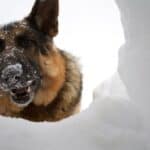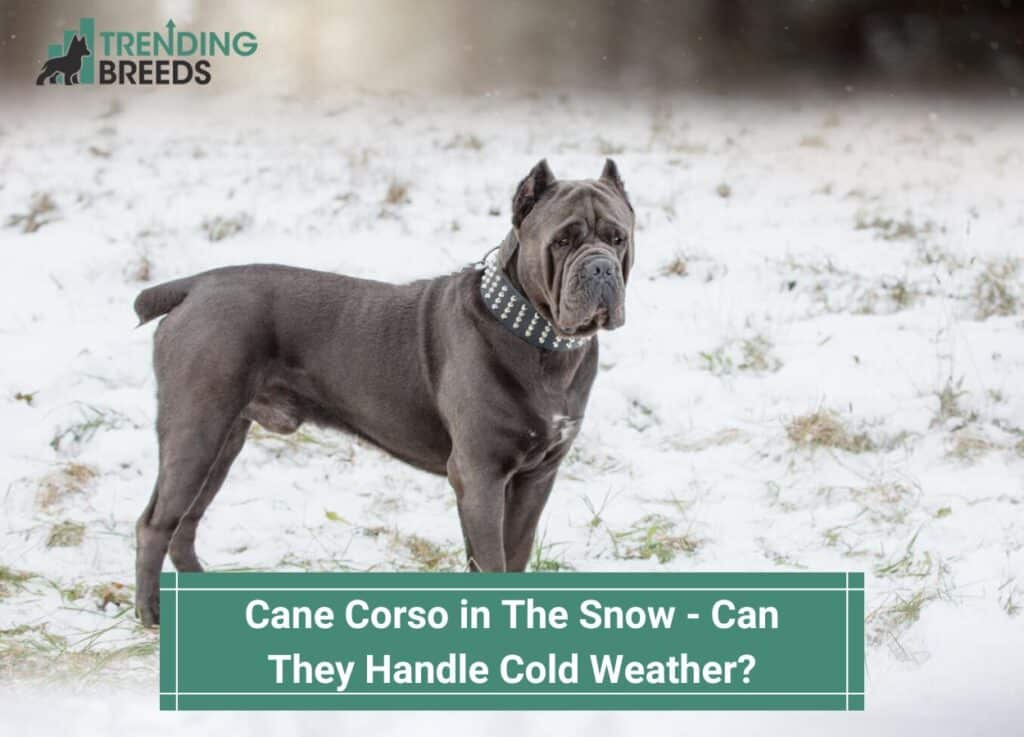
Cane Corso’s may like the snow, but can they handle cold weather? While these dogs mostly live inside, they also love the outdoors. However, once the weather reaches a specific temperature, it’s not safe for them to be outside.
The Cane Corso typically can live outside part of the time, but the breed may not be suitable for frigid cold air.
This guide will tell you everything from colder climates to regulating temperature exposure. Also, you’ll know the possible risks to look out for regarding your Cane Corso. From mild symptoms to severe, it’s essential to take action.
So, before arranging playtime with your Cane Corso in the snow, let’s discuss how they handle the cold.
Other articles you would like: Are Cane Corsos Naturally Protective? and Can A Cane Corso Live Outside?
Table of Contents
Living in Colder Climates
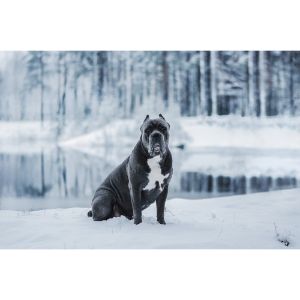
The Cane Corso breed loves being outside, especially in milder climates. The breed doesn’t mind colder temperatures as they can adapt quickly. However, they don’t like extreme coldness.
Since the Cane Corso comes from the Mediterranean, they thrive in moderate temperatures. The Cane Corso’s ideal temperature ranges from 43 to 58 degrees.
When temperatures swing to 30 degrees or colder, that’s when they may become sensitive. It’s a good idea for the Cane Corso to wear a coat or sweater to keep them warm and comfortable outdoors.
If not, then perhaps going inside is best. The breed has minimal fat on their bodies. Additionally, the Cane Corso doesn’t have large muscles for protection.
However, if you decide to keep your dog outside, you shouldn’t leave them out long. You should also supervise them. The Cane Corso breed has an energetic and athletic temperament. So, keeping your dog active with plenty of movement is excellent for their needs.
Additionally, when outdoors, it’s imperative to take short walks. Like humans, they’ll need to warm up before exercising during the winter. It’s best to keep exercise minimal for the first few minutes.
You should take the rest of the workout indoors if it’s below freezing. Keep your house free of clutter, so they can roam in the house when temperatures plummet.
Two hours of exercise is the average time your Cane Corso needs daily. When the breed is fully grown, that’s when physical activity goes from 15 minutes to two hours.
Therefore, you must walk and play whenever necessary, even in the winter. So, although your Cane Corso may feel intrigued by snow, it’s not the best idea for your dog breed.
Do Cane Corso’s Enjoy the Snow?
While Cane Corso’s enjoy physical activity, they suit warmer climates better. So, they don’t particularly like the snow for long periods.
However, the breed is curious about snow and may want to play in the snow at first. That’s when you should be on high alert in freezing temperatures.
Although, If the temperature is above 32 degrees, they may attempt to discover and play in the snow. Once the coldness hits their paws, they may want to race inside.
Unlike the German Shepherd or the Siberian Husky, the Cane Corso doesn’t do as well in the snow. The difference is due to their thicker coats, where the Cane Corso is in the moderate coat range.
However, the breed does do better than thinner coat breeds. So, while they may not enjoy the snow as much as other dogs, it may depend on the day-to-day. Sometimes, exposing them to cooler temperatures before winter can help.
Exposing Your Cane Corso To Colder Temperatures
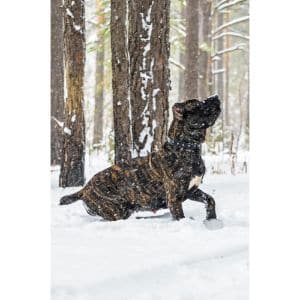
They can adjust if you recently moved or are visiting a colder climate. Although, it may take time for your Cane Corso to warm up to cold temperatures. Naturally, many Cane Corso’s grow an undercoat during the winter months.
The undercoat can grow thick. However, it also depends as all Cane Corso’s differ. Some dogs may never like the cold.
For instance, if your dog has a shorter coat, it may want to stay indoors until spring. Either way, the Cane Corso needs time to adjust. To safely expose the breed to colder temperatures, it’s good to train during warmer months.
The best time is during the summer months and perhaps fall. By fall, temperatures start to decline, which will help their undercoat.
Before winter, see if your Cane Corso’s undercoat is getting thicker. If not, it’s best to stay inside as often as possible. However, if your dog’s coat grows, there are ways to keep them comfortable when outside.
Having a shelter in your yard outside can help. If the shelter is adequately insulated, your dog will feel at home. The shelter or dog house should be tall enough that your Cane Corso can stand up comfortably.
Whether windy, rainy, or snowy, it’s good to have extra warmth and dry indoor space.
Age is a factor when contemplating if you, Cane Corso, should go outside. If your Cane Corso is at least six months old, they can safely enjoy the outdoors.
However, your dog may not adjust to coldness as quickly if they are older. In addition, an older dog is seven years or older. Therefore, they may have additional health concerns.
Regardless of age, it’s crucial to be aware of weather risks before taking your Cane Corso in the snow.
Risks of Cold Weather
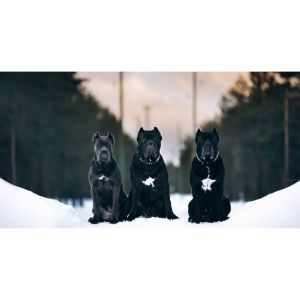
Risks are also involved when your Cane Corso is in the snow and embraces colder weather.
First, hypothermia can happen as soon as freezing temperatures occur. There’s a greater risk if your Cane Corso is old or young. Either way, it’s critical to know the signs and symptoms.
Symptoms to look out for include the following:
- Pale eyelids
- Pale, blue gums
- Dilated pupils
- Trembling, shivering
- Slower heart rate
- Weakness, lethargy
Your dog may have a body temperature below 95 degrees if exposed. Naturally, the breed doesn’t have a large percentage of body fat. So, if your Cane Corso feels cold, hypothermia is possible.
They may have trouble walking or breathing, which is severe. Additionally, unresponsiveness can occur. When this happens, death is possible.
Early detection can save lives. So, if your dog has any symptoms, reach out right away. If your Cane Corso has minimal signs, seek shelter as soon as possible. Then, keep them warm with a blanket.
However, take appropriate action if they become unconscious or have severe symptoms. When in doubt, take them to an animal hospital as it’s an emergency.
Aside from hypothermia, other health conditions can worsen, including hip dysplasia. While hip dysplasia is popular in the breed, coldness increases pain. While their physical health is essential, so is their mental health.
The Cane Corso can suffer mentally outside without enough stimulation. Staying active and being with people can help.
So, never leave your dog alone outside, especially during cold weather. If your Cane Corso is alone, they may bark loudly.
Additional Steps To Keep Your Cane Corso Warm
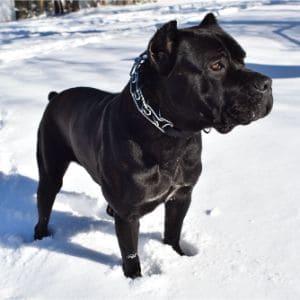
Before an emergency, it’s essential to keep your dog warm beforehand. If your dog doesn’t mind the cold, stay outdoors and play for ten minutes.
If snow falls, it’s critical not to exceed a specific time limit. A limit of 15 minutes should be the maximum amount to ensure safety.
However, avoiding the outdoors isn’t realistic, as the Cane Corso needs to move around. The goal is to spend less time outside.
For instance, when taking your Cane Corso to the bathroom, remember to be quick. It’s easy to get distracted. However, frostbite and hypothermia can get serious fast.
Less time outdoors will make regulating their temperature easier overall. From going outside to inside, the process will be less noticeable. Plus, a heater or heating pad indoors can help the warming transition.
While space heaters come in handy, your dog shouldn’t be alone with one in the room. Additionally, your Cane Corso can get burned if they get close.
Similarly, if you have a fireplace, keep a close eye as flames can be dangerous. If you have a safety screen, that’s a plus. Also, keep your Cane Corso in the warmest room of your house to keep them comfortable. Fuzzy blankets in their beds are a must.
Overall, there are many precautions to watch for regarding your Cane Corso. Luckily, you can avoid a disaster by implementing steps and taking precautions.
Aside from wearing sweaters and jackets, you can purchase booties. Booties on your Cane Corso’s feet and paws will provide extra warmth.
While they may not play outside in the cold for very long, they can safely get adequate movement in a short period.
Conclusion For “Cane Corso in The Snow – Can They Handle Cold Weather?“
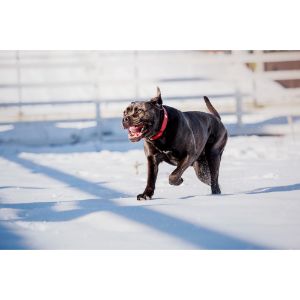
There are other dog breeds suitable for colder weather, especially snow. However, the Cane Corso does better than others due to their double coats.
While they are active breeds, they need to frolic outside with adequate space. Although, it’s crucial to take precautions if it’s below freezing.
The health and safety of your Cane Corso are essential. Avoiding hypothermia, frostbite, and other ailments is possible. In addition, you must take emergency action immediately if severe symptoms occur.
So, your guide to Cane Corso’s in colder weather is complete. Perhaps it’s time to avoid taking your Cane Corso in the snow.
You will also like:
For more information about the Cane Corso Breed, check out the video below:



